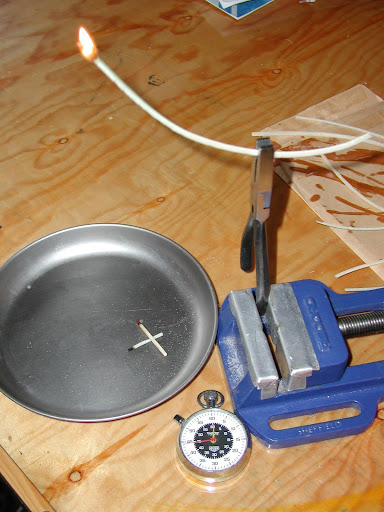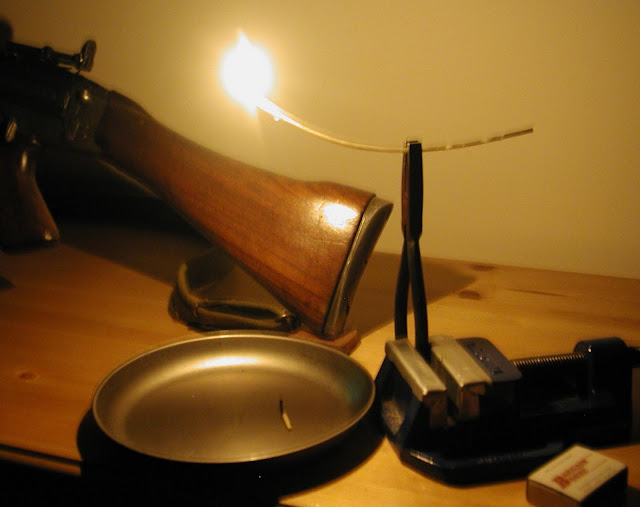Cheers!
The Selbourne letters are on line at the Guttenburg project and are great!
"To The Honourable Daines Barrington
Selborne, Nov. 1, 1775.
Dear Sir,
Hic ... taedae pingues, hic plurimus ignis
Semper, et assidua postes fuligine nigri.
I shall make no apology for troubling you with the detail of a very
simple piece of domestic Economy, being satisfied that you think
nothing beneath your attention that tends to utility: the matter
alluded to is the use of rushes instead of candles, which I am well
aware prevails in many districts besides this; but as I know there
are countries also where it does not obtain, and as I have
considered the subject with some degree of exactness, I shall
proceed in my humble story, and leave you to judge of the
expediency.
The proper species of rush for this purpose seems to be the juncus
effusus, or common soft rush, which is to be found in most moist
pastures, by the sides of streams, and under hedges. These rushes
are in best condition in the height of summer; but may be gathered,
so as to serve the purpose well, quite on to autumn. It would be
needless to add that the largest and longest are best. Decayed
labourers, women, and children, make it their business to procure
and prepare them. As soon as they are cut they must be flung into
water, and kept there; for otherwise they will dry and shrink, and
the peel will not run. At first a person would find it no easy matter
to divest a rush of its peel or rind, so as to leave one regular,
narrow, even rib from top to bottom that may support the pith: but
this, like other feats, soon becomes familiar even to children; and
we have seen an old woman, stone-blind, performing this business
with great dispatch, and seldom failing to strip them with the nicest
regularity. When these junci are thus far prepared, they must lie out
on the grass to be bleached, and take the dew for some nights, and
afterwards be dried in the sun.
Some address is required in dipping these rushes in the scalding fat
or grease; but this knack also is to be attained by practice. The
careful wife of an industrious Hampshire labourer obtains all her
fat for nothing; for she saves the scumrnings of her bacon-pot for
this use; and, if the grease abounds with salt, she causes the salt to
precipitate to the bottom, by setting the scummings in a warm
oven. Where hogs are not much in use, and especially by the sea-
side, the coarser animal oils will come very cheap. A pound of
common grease may be procured for four pence; and about six
pounds of grease will dip a pound of rushes; and one pound of
rushes may be bought for one shilling: so that a pound of rushes,
medicated and ready for use, will cost three shillings. If men that
keep bees will mix a little wax with the grease, it will give it a
consistency, and render it more cleanly, and make the rushes burn
longer: mutton-suet would have the same effect.
A good rush, which measured in length two feet four inches and an
half, being minuted, burnt only three minutes short of an hour: and
a rush still of greater length has been known to burn one hour and a
quarter.
These rushes give a good clear light. Watch-lights (coated with
tallow), it is true, shed a dismal one, 'darkness visible'; but then the
wicks of those have two ribs of the rind, or peel, to support the
pith, while the wick of the dipped rush has but one. The two ribs
are intended to impede the progress of the flame, and make the
candle last.
In a pound of dry rushes, avoirdupois, which I caused to be
weighed and numbered, we found upwards of one thousand six
hundred individuals. Now suppose each of these burns, one with
another, only half an hour, then a poor man will purchase eight
hundred hours of light, a time exceeding thirty-three entire days,
for three shillings. According to this account each rush, before
dipping, costs 1/33 of a farthing, and 1/11 afterwards. Thus a poor
family will enjoy 5&1/2 hours of comfortable light for a farthing.
An experienced old housekeeper assures me that one pound and a
half of rushes completely supplies his family the year round, since
working people burn no candle in the long days, because they rise
and go to bed by daylight.
Little farmers use rushes much in the short days, both morning and
evening in the dairy and kitchen; but the very poor, who are always
the worst economists, and therefore must continue very poor, buy
an halfpenny candle every evening, which, in their blowing open
rooms, does not burn much more than two hours. Thus have they
only two hours' light for their money instead of eleven.
While on the subject of rural oeconomy, it may not be improper to
mention a pretty implement of housewifery that we have seen no
where else; that is, little neat besoms which our foresters make
from the stalk of the polytricum commune, or great golden maiden-
hair, which they call silk-wood, and find plenty in the bogs. When
this moss is well combed and dressed, and divested of its outer
skin, it becomes of a beautiful bright chestnut colour; and, being
soft and pliant, is very proper for the dusting of beds, curtains,
carpets, hangings, etc. If these besoms were known to the
brushmakers in town, it is probable they might come much in use
for the purpose above-mentioned.*
(*A besom of this sort is to be seen in Sir Ashton Lever's Museum.)
I am, etc."
As to why, oh no good reason apart from a interest in historical lighting devices, faffing about and projects the lads can join in. I'll probably dump some on a mate who does live role play if I get carried away. So far my main problem has been finding a friendly butcher to supply me with mutton fat to render into tallow. I'm half tempted to buy some plumbers best white tallow (mutton and beef fat based) but its very expensive for what it is.
The next time I see some (which almost guarantees I won't for a long time) I will aquire some old rusty or even broken pincers (things I have turnd my nose up at in the past at car boots etc) and fix one arm iito a wooden block and crudely (the only way I know!) forge/bend the other up (suitably shortened) to aproximate a nip. I'll let the middle lad take it into school as his teacher loves anything "historical" like this and she can use it to demonstate with.
Cheers
Tom


